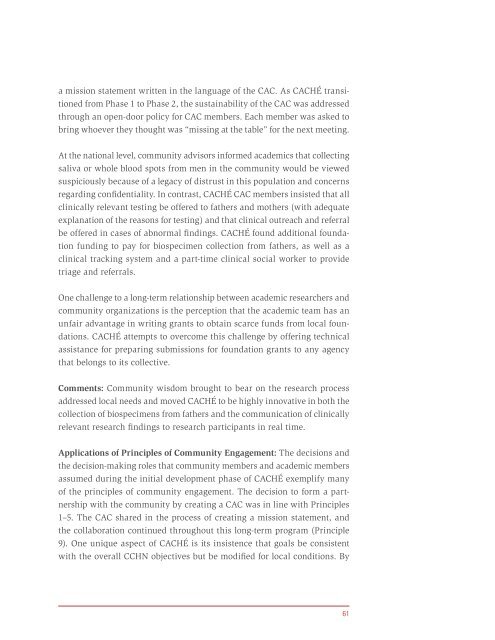Principles of Community Engagement (Second Edition)
Principles of Community Engagement (Second Edition)
Principles of Community Engagement (Second Edition)
You also want an ePaper? Increase the reach of your titles
YUMPU automatically turns print PDFs into web optimized ePapers that Google loves.
a mission statement written in the language <strong>of</strong> the CAC As CACHÉ transi-<br />
tioned from Phase 1 to Phase 2, the sustainability <strong>of</strong> the CAC was addressed<br />
through an open-door policy for CAC members Each member was asked to<br />
bring whoever they thought was “missing at the table” for the next meeting<br />
At the national level, community advisors informed academics that collecting<br />
saliva or whole blood spots from men in the community would be viewed<br />
suspiciously because <strong>of</strong> a legacy <strong>of</strong> distrust in this population and concerns<br />
regarding confidentiality In contrast, CACHÉ CAC members insisted that all<br />
clinically relevant testing be <strong>of</strong>fered to fathers and mothers (with adequate<br />
explanation <strong>of</strong> the reasons for testing) and that clinical outreach and referral<br />
be <strong>of</strong>fered in cases <strong>of</strong> abnormal findings CACHÉ found additional foundation<br />
funding to pay for biospecimen collection from fathers, as well as a<br />
clinical tracking system and a part-time clinical social worker to provide<br />
triage and referrals<br />
One challenge to a long-term relationship between academic researchers and<br />
community organizations is the perception that the academic team has an<br />
unfair advantage in writing grants to obtain scarce funds from local foundations<br />
CACHÉ attempts to overcome this challenge by <strong>of</strong>fering technical<br />
assistance for preparing submissions for foundation grants to any agency<br />
that belongs to its collective<br />
Comments: <strong>Community</strong> wisdom brought to bear on the research process<br />
addressed local needs and moved CACHÉ to be highly innovative in both the<br />
collection <strong>of</strong> biospecimens from fathers and the communication <strong>of</strong> clinically<br />
relevant research findings to research participants in real time<br />
Applications <strong>of</strong> <strong>Principles</strong> <strong>of</strong> <strong>Community</strong> <strong>Engagement</strong>: The decisions and<br />
the decision-making roles that community members and academic members<br />
assumed during the initial development phase <strong>of</strong> CACHÉ exemplify many<br />
<strong>of</strong> the principles <strong>of</strong> community engagement The decision to form a partnership<br />
with the community by creating a CAC was in line with <strong>Principles</strong><br />
1–5 The CAC shared in the process <strong>of</strong> creating a mission statement, and<br />
the collaboration continued throughout this long-term program (Principle<br />
9) One unique aspect <strong>of</strong> CACHÉ is its insistence that goals be consistent<br />
with the overall CCHN objectives but be modified for local conditions By<br />
61

















